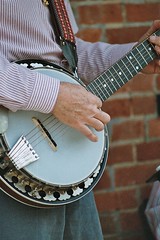The banjo is a stringed instrument developed by enslaved Africans in the United States, adapted from several African instruments.[1] The name banjo commonly is thought to be derived from the Kimbundu term mbanza. Some etymologists derive it from a dialectal pronunciation of "bandore", though recent research suggests that it may come from a Senegambian term for the bamboo stick used for the instrument's neck, says Wikipedia.
The banjo can be played in several styles and is used in various forms of music. American old-time music typically uses the five-string open back banjo. It is played in a number of different styles, the most common of which are called clawhammer (or "claw-hammer") and frailing, characterised by the use of a downward rather than upward motion when striking the strings with the fingers. Banjo picks are usually inserted onto the fingers for a smoother playing.
The plectrum banjo has four strings, lacking the shorter fifth drone string, and around 22 frets. As the name suggests, it is usually played with a guitar-style pick (that is, a single one held between thumb and forefinger), unlike the five-string banjo, which is either played with a thumbpick and two fingerpicks, or with bare fingers.
The plectrum banjo evolved out of the five-string banjo, to cater to styles of music involving strummed chords.
The tenor banjo has become a standard instrument for Irish traditional music. The tenor banjo was also a common rhythm instrument in early jazz and dance bands throughout the 1920s and 1930s. Its volume and timbre suited early jazz (and jazz-influenced popular music styles) and could both compete with other instruments (such as brass instruments and saxophones) and be heard clearly on acoustic recordings. However, as the guitar gained in popularity in the 1930s, the tenor banjo moved out of mainstream jazz and popular music finding a place in traditional jazz and Dixieland jazz.
Tuesday, November 11, 2008
Subscribe to:
Post Comments (Atom)





No comments:
Post a Comment